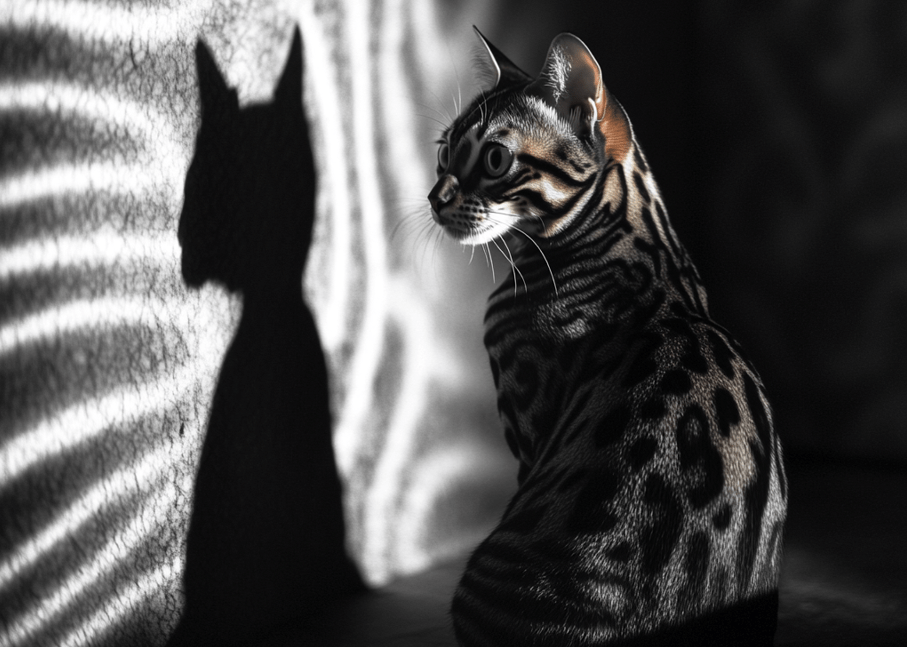
Bengal cats are intelligent, energetic, and highly trainable, making them perfect candidates to teach your Bengal cat tricks like fetch, sit, or even more advanced behaviors. Their curious nature and love for interaction mean they thrive on mental stimulation, and training them can strengthen your bond while keeping them engaged. This comprehensive guide will walk you through the process of teaching your Bengal cat tricks, offering step-by-step instructions, practical tips, and insights to ensure success. Whether you’re a first-time cat owner or an experienced trainer, this article will help you unlock your Bengal’s potential.
Why Teach Your Bengal Cat Tricks?
Bengals are a unique breed with a mix of wild ancestry and domestic charm. Their intelligence and energy make them ideal for learning tricks, but why should you invest time in training?

Mental Stimulation: Bengals need mental challenges to prevent boredom, which can lead to destructive behaviors like scratching or chewing.
Physical Exercise: Tricks like fetch or jumping provide an outlet for their high energy levels.
Strengthened Bond: Training fosters trust and communication between you and your Bengal.
Behavioral Benefits: Teaching tricks can reinforce good manners, such as sitting calmly or coming when called.
Fun and Enrichment: Both you and your Bengal will enjoy the interactive, rewarding process of learning new skills.
With the right approach, teaching tricks can be a fun and fulfilling experience for both you and your cat.
Understanding Your Bengal’s Learning Style
Before diving into specific tricks, it’s important to understand how Bengals learn. Their intelligence and curiosity make them quick learners, but their independent nature requires a tailored approach.
Key Characteristics of Bengal Cats
High Intelligence: Bengals are problem-solvers who enjoy challenges and puzzles.
Energy and Playfulness: They respond well to training that incorporates play and movement.
Short Attention Spans: Bengals may lose interest quickly, so keep sessions short and engaging.
Food Motivation: Many Bengals are driven by treats, making positive reinforcement effective.
Social Nature: They enjoy interaction with their owners, which can be leveraged during training.
Training Principles for Success
Positive Reinforcement: Reward desired behaviors with treats, praise, or play to encourage repetition.
Consistency: Use the same cues, rewards, and techniques to avoid confusion.
Patience: Every cat learns at their own pace, so stay calm and avoid frustration.
Short Sessions: Train for 5–10 minutes, 2–3 times daily, to maintain focus.
Fun Environment: Make training feel like a game to keep your Bengal engaged.
By aligning your training methods with your Bengal’s personality, you’ll set the stage for successful trick training.
Essential Tools for Training Your Bengal Cat
To teach your Bengal cat tricks, you’ll need a few tools to make the process smooth and effective:
Treats: Use small, high-value treats like freeze-dried chicken, tuna, or commercial cat treats. Ensure they’re easy to eat quickly.
Clicker: A clicker is a small device that makes a distinct sound to mark correct behaviors, helping your cat associate the sound with a reward.
Toys: For tricks like fetch, use lightweight toys like balls, stuffed mice, or crinkle toys that your Bengal loves to chase.
Target Stick: A stick or wand can guide your cat into specific positions, such as sitting or jumping.
Training Mat or Platform: A small mat or raised surface can help teach stationary tricks like “sit” or “stay.”
Quiet Space: Choose a distraction-free area for training to keep your Bengal focused.
With these tools in hand, you’re ready to start teaching your Bengal some impressive tricks.
Step-by-Step Guide to Teaching Tricks
Below, we’ll cover how to teach three popular tricks—fetch, sit, and come—along with tips for success. These tricks build on each other, starting with simple behaviors and progressing to more complex ones.

Trick 1: Teaching Your Bengal to Fetch
Fetch is a natural trick for Bengals, as their hunting instincts make them love chasing and retrieving objects.
Steps to Teach Fetch
Choose a Toy: Select a lightweight toy your Bengal enjoys, such as a small ball or stuffed mouse.
Spark Interest: Toss the toy a short distance and encourage your cat to chase it. If they pick it up, praise them.
Encourage Retrieval: Call your Bengal back while holding a treat. If they bring the toy, click the clicker (if using) and reward them.
Reinforce the Behavior: Gradually withhold the treat until they consistently bring the toy back. Add a cue like “fetch” when they start to understand.
Increase Distance: Toss the toy farther as your Bengal gets better at retrieving it.
Practice Regularly: Keep sessions fun and short, practicing daily to solidify the behavior.
Tips for Success
-
Use a toy your Bengal already loves to increase motivation.
-
If your cat doesn’t bring the toy back, try running away to encourage them to follow you.
-
Reward even partial successes (e.g., picking up the toy) to build confidence.
Trick 2: Teaching Your Bengal to Sit
Teaching “sit” is a foundational trick that helps with other behaviors, like staying calm or waiting for food.
Steps to Teach Sit
Get Your Cat’s Attention: Hold a treat above your Bengal’s nose in a quiet area.
Guide the Position: Slowly move the treat back over their head. As their butt lowers to the ground, say “sit” and click the clicker (if using).
Reward Immediately: Give the treat and praise as soon as they sit.
Repeat and Refine: Practice several times, gradually reducing the treat’s movement until they sit on the verbal cue alone.
Add Duration: Ask your Bengal to stay seated for a few seconds before rewarding, building up to longer sits.
Generalize the Trick: Practice in different locations to ensure they respond to “sit” anywhere.
Tips for Success
-
Keep the treat close to their nose to avoid jumping.
-
If your Bengal stands or walks backward, try training near a wall to limit movement.
-
Be patient, as some cats take longer to associate the cue with the action.
Trick 3: Teaching Your Bengal to Come
Teaching your Bengal to come when called is useful for safety and bonding.
Steps to Teach Come
Start Close: Stand a few feet away from your Bengal in a quiet area, holding a treat or toy.
Use a Cue: Say your cat’s name followed by “come” in an upbeat tone (e.g., “Leo, come!”).
Encourage Movement: Show the treat or toy to lure them toward you. When they move closer, click and reward.
Increase Distance: Gradually move farther away, repeating the cue and rewarding when they come to you.
Practice in Context: Try calling them from another room or during play to make the behavior reliable.
Fade the Lure: Reduce reliance on treats by rewarding with praise or play occasionally.
Tips for Success
-
Use a consistent tone and cue to make the command clear.
-
Never punish your cat for not coming, as this can create fear.
-
Practice in low-distraction environments before adding challenges.
Advanced Tricks for Your Bengal Cat
Once your Bengal masters basic tricks, you can move on to more advanced behaviors to keep them challenged.
Trick 4: High-Five
Start with Sit: Ask your Bengal to sit, then hold a treat just above their paw.
Encourage Paw Movement: When they lift their paw to reach the treat, say “high-five,” click, and reward.
Refine the Motion: Reward only when they touch your hand with their paw, gradually raising your hand higher.
Add the Cue: Use “high-five” consistently, phasing out the treat lure.
Trick 5: Spin
Lure with a Treat: Hold a treat near your Bengal’s nose and move it in a circle around their head.
Reward the Turn: When they follow the treat and spin, say “spin,” click, and reward.
Add the Cue: Practice until they spin on the verbal cue alone, fading the treat lure.
Practice Both Directions: Teach spins in both directions for added challenge.
Trick 6: Jump Through a Hoop

Introduce the Hoop: Hold a hula hoop or similar object on the ground and lure your Bengal through with a treat.
Reward the Action: Say “jump,” click, and reward when they walk through.
Raise the Hoop: Gradually lift the hoop off the ground, rewarding only when they jump through.
Add Distance: Increase the distance between your Bengal and the hoop for a more impressive trick.
Common Challenges and Solutions
Training a Bengal cat can come with challenges. Here’s how to address common issues:
Lack of Interest: If your Bengal seems uninterested, try higher-value treats, a different toy, or a more engaging environment. Keep sessions short and fun.
Distractions: Train in a quiet space and gradually introduce distractions as your cat improves.
Inconsistent Responses: Ensure everyone in the household uses the same cues and rewards to avoid confusion.
Overexcitement: If your Bengal gets too excited and bites or scratches, pause the session and resume when they’re calmer.
Slow Progress: Break tricks into smaller steps and reward incremental progress to build confidence.
Tips for Long-Term Success
To keep your Bengal engaged and ensure lasting results, follow these tips:
Vary the Tricks: Introduce new tricks regularly to keep training exciting.
Incorporate Tricks into Daily Life: Use “sit” before meals or “come” during play to reinforce behaviors.
Maintain a Routine: Schedule regular training sessions to keep skills sharp.
Stay Positive: Always end sessions on a positive note, even if progress is slow.
Monitor Health: Ensure your Bengal is healthy, as pain or illness can affect their ability to learn.
Myths About Training Bengal Cats
Let’s debunk some common misconceptions about teaching Bengals tricks:
Myth: Cats Can’t Be Trained Like Dogs: Bengals are highly trainable with the right methods, often rivaling dogs in their ability to learn.
Myth: Training Is Time-Consuming: Short, consistent sessions can yield impressive results without taking up much time.
Myth: Bengals Are Too Independent: While independent, Bengals love interaction and respond well to training that feels like play.
When to Seek Professional Help
If you’re struggling to teach your Bengal tricks or notice behavioral issues, professional help can be valuable.
Certified Cat Trainers: A professional trainer can provide personalized guidance and troubleshoot challenges.
Feline Behaviorists: For complex issues, a behaviorist can assess your cat’s environment and motivations.
Veterinary Check-Up: Rule out health problems that may affect focus or behavior, such as dental issues or pain.
Conclusion

Teaching your Bengal cat tricks like fetch, sit, or even high-five is a rewarding way to engage their intelligence, burn energy, and deepen your bond. By using positive reinforcement, keeping sessions fun, and tailoring your approach to your Bengal’s personality, you can unlock their potential and create a well-behaved, happy companion. Start with simple tricks, build on their successes, and gradually introduce more advanced behaviors to keep them challenged. With patience, consistency, and love, your Bengal will soon be showing off their new skills, delighting everyone around them.
Begin your training journey today, and watch your Bengal shine as they master tricks that showcase their unique charm and intelligence.




